WordPress Plugins For Managing WordPress Post Revisions
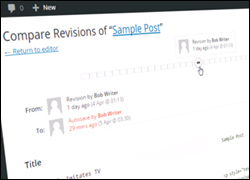
In a separate tutorial, we looked at the WordPress Post Revisions feature, where WordPress saves all your post revisions, so you can always go back to an earlier version of what you have written and restore it.
In this tutorial, we look at a number of WordPress plugins that will help you manage your post revisions.
Managing Post Revisions – WordPress Plugins
As soon as you edit and save posts and pages, WordPress begins to store new post revisions in its database. You can see these displayed in a Revisions box at the bottom of your page editor …
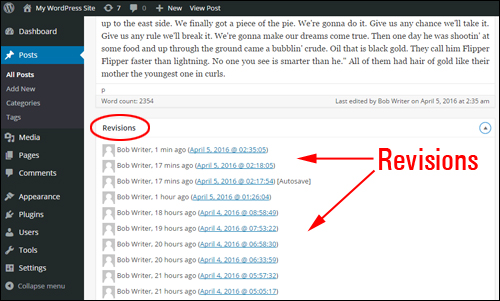
(Post Editor screen – View the WordPress post revisions box)
Autosave and revisions are no doubt functions that help make work more productive. If you write a lot of content, however, the revisions can start building up. This can significantly grow the size of your WordPress database, so it’s important to manage your revisions.
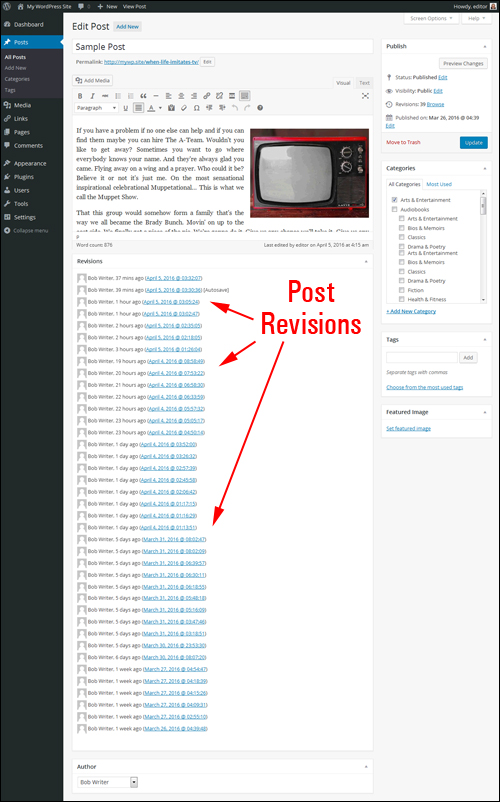
(As post revisions accumulate, your WordPress database could be storing lots of unnecessary data)
For example, if there are 200 posts on your site with an average of 10 revisions each you could be storing an extra 2,000 copies of old data. If your post is approximately 100KB data, then with 2,000 revisions, the total database space wasted is about 200MB.
The good news is that there are a number of WordPress plugins available to help you control and manage your revisions and reduce the size of your database. Let’s take a look at some of these:
Better Delete Revision
(Better Delete Revision)
Better Delete Revision removes redundant revisions of posts from your database and other database content associated with each revision like meta information, relationships, tags, and more.
After the plugin has been installed and activated, Better Delete Revision can perform optimizations on your WordPress database without having to log into your server.
Log into the WordPress Dashboard and choose Settings > Better Delete Revision …

(WP Settings Menu – Better Delete Revision)
This brings you to the Better Delete Revision Manager area. Click ’Check Revision Posts’ to calculate the number of redundant post revisions can be safely deleted from the database …

(Better Delete Revision – Check Revision Posts)
Depending on the number of posts and revisions associated with each post entry, the plugin calculates and returns a list of post revisions stored in the database …
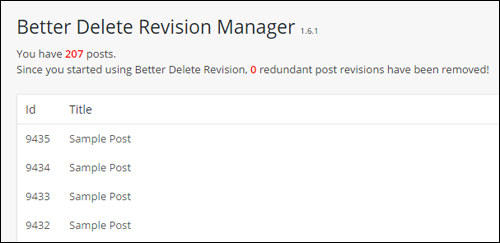
(Better Delete Revision – List of post revisions)
Click on ‘Yes, I would like to delete them! …’ to remove all list items from your database, or select ‘No, I prefer to keep them!’ to abandon the task and exit the plugin …
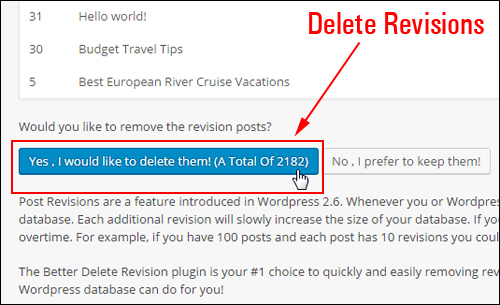
(Better Delete Revision – Delete posts revisions list)
The unnecessary items will be removed from the database …
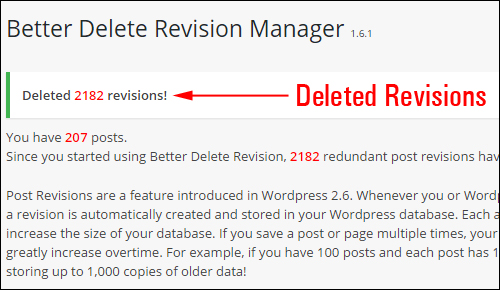
(List of post revisions cleared – Better Delete Revision)
![]()
As WordPress automatically stores all new revisions, the process will automatically begin again (unless you have turned the feature off). After a period of time, we recommend running the tool again to keep your database as light as possible …
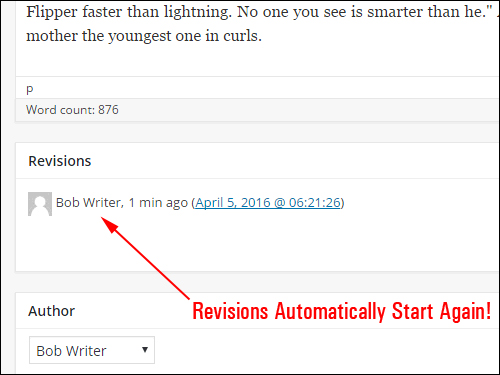
(WordPress automatically begins storing your new post revisions again!)
Like the other plugins described further below, you can also use this plugin to keep your site’s database optimized …

(Keep the database optimized)
The plugin checks to see if the database tables need optimization and runs an easy one-click database table optimization routine without requiring you to log into your server panel or mess with technical database management applications …
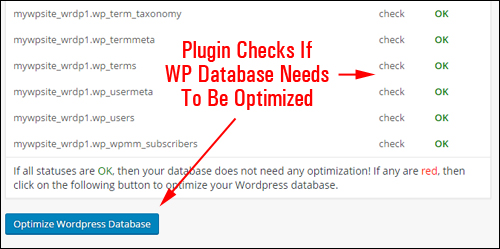
(Better Delete Revision checks if the WP database needs optimization)
For more details, go here: Better Delete Revision Plugin For WordPress
Optimize Database after Deleting Revisions
(Optimize Database after Deleting Revisions – WordPress Plugin)
OptimizeDatabase not only can be used to remove redundant post and page revisions (it also lets you keep an ‘x’-amount of the most recent revisions) and checks if the WP database needs cleaning and optimization, it also lets you perform the following optional tasks:
- Delete trashed comments, posts, and pages
- Delete unused tags
- Delete ’pingbacks’ and ‘trackbacks’
- Exclude certain tables or specific posts/pages from cleaning and optimization
- Automatically schedule optimizations
- And more!
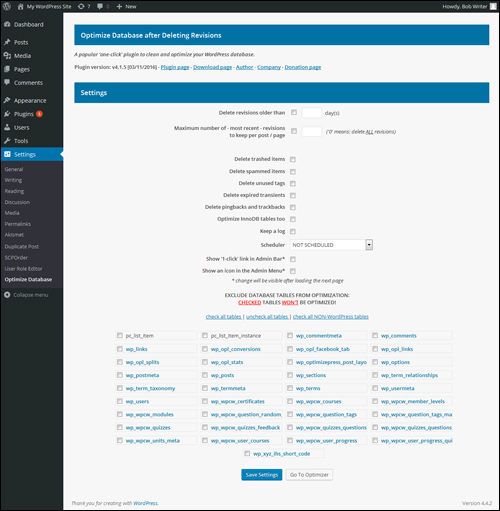
(Optimize Database after Deleting Revisions – Settings)
For more details, go here: Optimize Database after Deleting Revisions Plugin For WordPress
WP Optimize
(WP Optimize Plugin)
In addition to performing tasks such as deleting unnecessary revisions of pages and posts and checking if your WP database tables need to be optimized, this plugin also lets you perform the following maintenance tasks:
- Enable/Disable comments for published posts
- Removal of stale unapproved comments
- Mobile device friendly
- Remove transient options
- Clean up auto draft posts
- Ability to retain selected number of weeks data when cleaning up
- Add or remove link on WP admin bar
- Enable/Disable weekly schedules of optimization
- Display database table statistics
- Receive email notifications after scheduled cleanups
- Marks potentially dangerous cleanup items in red
- And more!
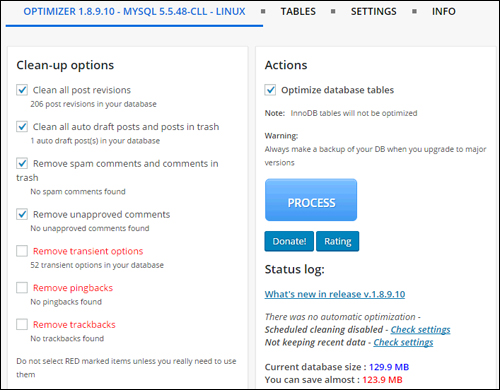
(WP-Optimize WP Plugin – Settings)
For more details, go here: WP Optimize – WordPress Plugin
WP Sweep
(WP-Sweep)
In addition to optimizing your database tables and deleting unnecessary revisions, WP-Sweep also cleans up:
- Auto drafts
- Spammed comments
- Orphan user meta
- Duplicated comment meta
- Transient options
- And more!
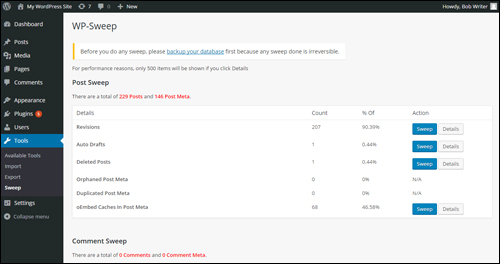
(WPSweep – Settings)
For more details, go here: WP-Sweep
Simple Revisions Delete

This lightweight and simple-to-use plugin lets you purge (delete) your posts revisions either individually or all at once.
Once the plugin has been installed and activated, for example, a ‘Purge’ link appears next to the Revisions section in your Publish box (and in other sections of your admin area) allowing you to safely delete revisions.

For more details, go here: Simple Revisions Delete
WP REVISIONS CONTROL

This plugin lets you specify the number of revisions retained for each post type in the Settings > Writing screen.

For more details, go here: WP Revisions Control
To view more plugins that can help you manage post revisions and optimize your database, go to Plugins > Add New and search for keywords like “Manage Revisions“, “Database Optimize“, etc …
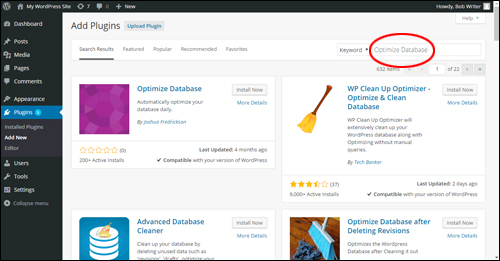
(Add Plugins – Plugins Menu)
We hope that you have found the above information on plugins that will help you manage your WordPress post revisions useful.
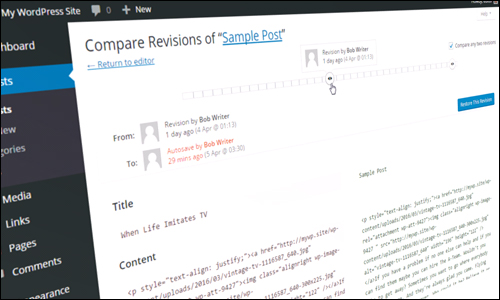
***
"I am beyond impressed with what you have put together. I can tell that you put a ton of hard work into building what you have. You have the absolute best content on WordPress I have ever seen!" - Robert T. Jillie
***



